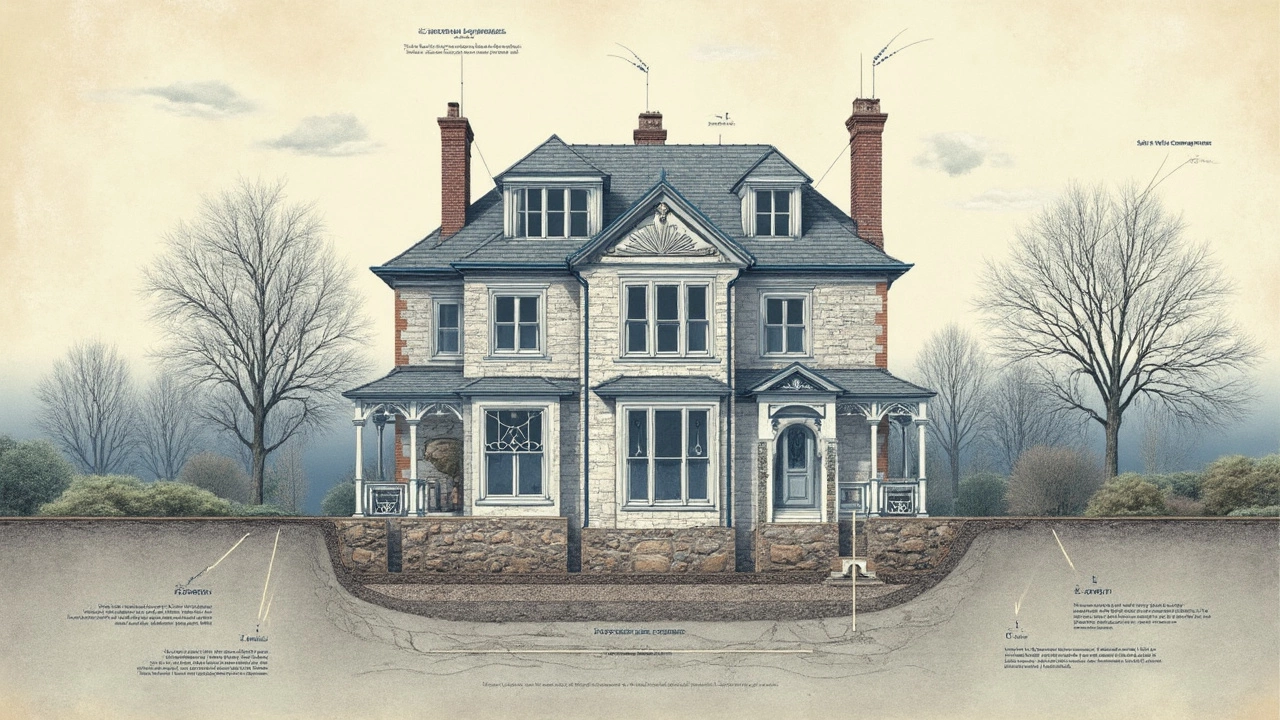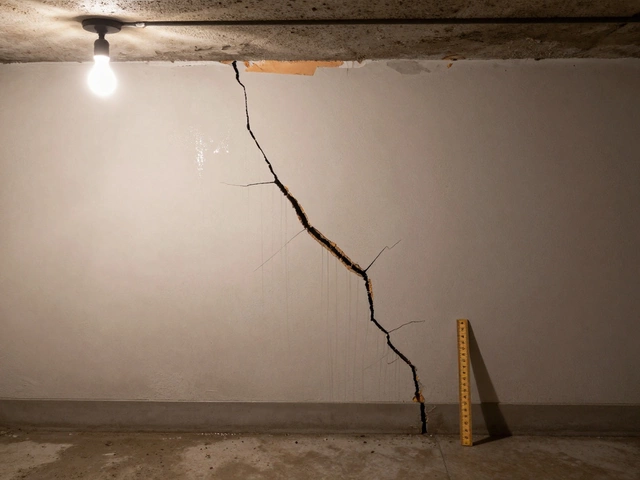If you've ever noticed slight cracks in the walls or doors that suddenly won't close properly, you might wonder if your home's foundation is settling—and if that's a big deal. Well, let's get one thing straight: some settling is entirely normal. Yeah, you heard it right! A bit of shifting happens to almost all homes over time, and it's usually nothing to panic about.
But here’s the catch—knowing when settling is just the house getting comfy on its plot, or when it's time to worry about potential damage. Wondering what normal settling looks like? Keep your eyes peeled for small hairline cracks in your drywall or slight tweaks in windows and doors. These can be par for the course.
Of course, it's not always that simple. Significant cracks, especially those wider than a quarter inch, could mean it's time to take action. The soil type your house is built on, weather conditions, and even tree roots can all play a role in how your foundation behaves. So, how do you keep your home steady as a rock? Regular maintenance and early checks can make a world of difference.
- What is Foundation Settling?
- Signs of Normal Settling
- When Settling Becomes a Problem
- Causes of Foundation Settling
- Preventing Foundation Issues
- When to Call a Professional
What is Foundation Settling?
Alright, so let's talk about foundation settling—something most homeowners have probably wondered about at some point. In simple terms, foundation settling is the natural process of your house adjusting to the earth beneath it. Over time, as the soil shifts and compresses under your home's weight, a bit of movement happens. It’s kind of like your house getting comfy in its new spot.
Now, imagine you just plopped down on a brand-new mattress. At first, it might feel a little stiff, but after a while, it breaks in, right? That's settling, but for your house! Usually, this kicks off during the first few years after construction when the building starts finding its place.
The Role of Soil and Environment
One big player in this process is the soil type. Some soils, like clay, expand and contract with moisture changes, while sandy soils usually stay stable. Hence, homes built on clay might experience more noticeable movement.
The environment around your property—weather conditions, water drainage, and even trees—can also influence settling. Heavy rains or drought conditions can majorly impact how the soil beneath your foundation shifts.
Natural vs. Worrisome Settling
It's important to distinguish between normal settling and something more serious. Natural settling typically results in minor cosmetic changes, but substantial gaps or buckling might be red flags. Keep an eye on significant changes!
Whether you're buying a new place or living in a long-standing home, being mindful of these nuances can save you headaches down the line. Foundation maintenance is not just about fixing issues but knowing what's normal so you can keep your home safe and sound.
Signs of Normal Settling
Your home's foundation is like that friend who cannot sit still. Over time, it’s going to move a bit, and that's usually okay. So, what exactly are the signs of normal settling?
Common Indicators to Keep an Eye On
Generally, a few indicators signal that your house is settling as expected. Here are some you might notice:
- Small Cracks in Drywall: It's pretty common to spot thin, hairline fractures forming on your walls. If they're vertical and less than a quarter inch wide, they’re likely harmless.
- Slight Door and Window Sticking: Doors and windows can become a tad sticky. They might need a slight push to shut properly as the house shifts.
- Uneven Floors: Floors might start to slope slightly. A marble rolling across the floor isn't great but isn't unheard of.
What the Experts Say
Learning from the pros is key. According to an article on This Old House, "Most foundations settle into place, and a few small cracks in the mortar are usually nothing to worry about."
Benjamin Tseng, a structural engineer, once said, "A little movement happens in almost every home. What's crucial is understanding when that movement becomes a problem requiring intervention."
Understanding Local Conditions
Your locale plays a massive role in how the foundation behaves. For instance, homes built on clay-heavy soils might see more movement compared to those on rocky or sandy grounds. Check out the soil type in your area to better understand the settling patterns you might face.
Document for Peace of Mind
One handy tip? Keep a log of any changes you notice. Take photos and jot down notes every few months. This way, you can track any shifts and catch if things escalate sooner rather than later.
When Settling Becomes a Problem
So, when does normal settling cross the line into something worth worrying about? The key is keeping an eye out for certain tell-tale signs. If you spot these, it might be time to call in the pros.
First off, pay attention to crack size. While small hairline cracks are typical, cracks wider than a quarter inch could be trouble. Big gaps, especially in brickwork or on your foundation walls, might indicate substantial movement.
Uneven floors are another red flag. If a ball rolls across your living room with no one to kick it, or if you feel like you're walking uphill in your own home, that's not just your imagination. These slopes might suggest something's up with your foundation stability.
Stuck Doors and Windows
When your doors or windows start sticking—or refuse to close altogether—it could be more than just humidity. Sometimes, it hints at foundation shifting, which throws your home off balance.
Water Woes
Check your basement or crawlspace for unwanted water. Pooling water or persistent dampness could point to a foundation problem, as water's a sneaky culprit for soil erosion and pressure changes against your foundation walls.
Foundation Repair Necessity
If any of these issues sound familiar, it's vital to look at foundation repair options. Maybe you'll need something simple, like re-leveling, or perhaps something more significant, like underpinning. Whatever the case, catching these problems early can save you stress and money in the long run.
Your intuition as a homeowner is critical—trust it. If you suspect something's off, don't hesitate to bring in a foundation repair expert. They're pros at diagnosing and fixing structural problems and can return peace of mind quicker than you might think.

Causes of Foundation Settling
Ever wonder why your home’s foundation might be shifting a bit? Well, it’s not as mysterious as it sounds. There are quite a few reasons why foundation settling happens, and understanding them could save you a headache down the road.
Soil Composition and Movement
The ground beneath your house plays a major role. Different types of soil expand and contract with moisture changes. For example, clay soils are notorious for swelling up when wet and shrinking when dry. This constant movement can cause your foundation to settle unevenly.
Weather Conditions
Believe it or not, the weather is also a culprit in foundation settling. Prolonged periods of drought can dry out the soil, while heavy rains can lead to excess moisture absorption. Both situations lead to shifting and settling.
Poor Drainage
If water isn’t properly directed away from your home through gutters or proper landscaping, it can pool around your foundation. Over time, this excess moisture can erode soil and compromise the stability of your foundation.
Tree Roots
Got big trees near your home? Their roots can wreak havoc on your foundation. As roots expand and search for water, they can push against the foundation, causing it to shift.
| Factor | Impact Level |
|---|---|
| Clay Soil Activity | High |
| Prolonged Rainfall | Medium |
| Poor Drainage | High |
| Tree Roots | Medium |
Preventing Foundation Issues
While dealing with foundation issues might seem daunting, the good news is there are plenty of steps you can take to keep these problems at bay. It starts with understanding your home’s environment and being proactive with maintenance. Let’s dive into some straightforward ways to prevent potential issues and keep your home’s foundation solid.
Manage Water Around Your Home
Water is a double-edged sword—essential for life, but potentially harmful to your foundation if not managed well. Make sure your gutters and downspouts are effective at redirecting rainwater away from your home. You want to avoid water pooling around the foundation at all costs, as excess moisture can lead to soil erosion or expansion.
- Clean gutters regularly to ensure they are free of debris.
- Direct downspouts at least 5 feet from foundation walls.
- Consider grading your yard so it slopes away from the home, preventing water from collecting near the foundation.
Regularly Inspect for Changes
Be your home’s detective! Keep an eye out for early warning signs of trouble. Catching issues early can save a lot of money down the road. Check for visible changes around the house, like cracks in walls or floors, and doors or windows that suddenly don't fit right anymore.
- Monitor small cracks to see if they expand.
- Note any patterns or sudden changes in how easily doors and windows open.
Soil Considerations
Your home’s soil is like its invisible support system. Different soil types expand and contract with moisture, impacting the foundation stability. Knowing what’s beneath your property can help you take appropriate measures.
If you’re dealing with clay soil, it’s known for expanding with moisture and shrinking when dry, putting pressure on the foundation. Adjust your landscaping strategy by choosing plants that don’t consume excessive groundwater or having a regular moisture management plan.
Foundation Maintenance and Repair
Nip potential issues in the bud with regular maintenance and timely repairs. A stitch in time saves nine, as the saying goes! Don't hesitate to bring in a professional if you notice anything that could spell trouble. They can provide an expert assessment and remedy issues before they become costly disasters.
| Prevention Tips | Average Cost |
|---|---|
| Regular Gutter Cleaning | $70-$200 |
| Foundation Inspection | $300-$600 |
| Grading Yard | $700-$1,500 |
A little attention now will pay off in the long-run. Maintain your home’s foundation like you would maintain your health, because once it falls apart, piecing it back together might not be as easy.
When to Call a Professional
Deciding when to involve a professional in foundation issues can be tricky, but getting it right can save your home from future headaches. There are clear signs when your foundation settling might need a closer look from the experts.
Watch for Major Cracks
If you spot substantial cracks, particularly those wider than a quarter inch, it's time to call in a pro. These aren't just cosmetic issues—they might signal deeper structural problems. Don't wait until they're too big to ignore.
Doors and Windows Misbehaving
Ever wrestled with a door or window that just won't shut? It might be more than just humidity. If these fixtures consistently stick, it can indicate shifts in the foundation that need professional attention.
Foundation Movement
Unexpected tilting or moving of the house's foundation should ring alarm bells. Professionals can assess and measure the movement, and determine what steps might be needed to stop things from getting worse.
Water Trouble
Water collecting in the basement or around the foundation is never a good sign. A foundation repair expert can evaluate drainage problems or waterproofing needs that might help you avoid serious damage down the road.
Professional Inspection Frequency
Even if you don't see obvious issues, regular inspections (every 3-5 years) can catch subtle changes early. Consider it preventative maintenance, like for your car.
| Sign to Watch | Action Needed |
|---|---|
| Cracks > 1/4 inch | Call a Professional |
| Persistent Door/Window Issues | Schedule an Evaluation |
| Pooling Water | Professional Drainage Assessment |
| Visible Foundation Movement | Immediate Professional Exam |
Remember, taking action sooner rather than later is often your best bet. It can mean the difference between a small repair and a major undertaking. So, keep an eye out, stay proactive, and don't hesitate to reach out to a foundation repair expert when needed!







